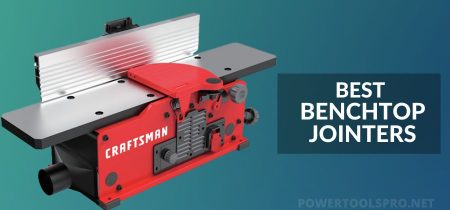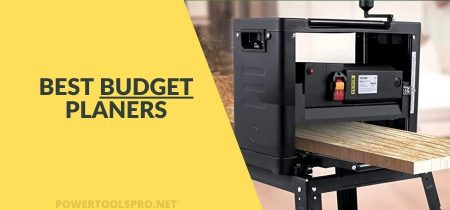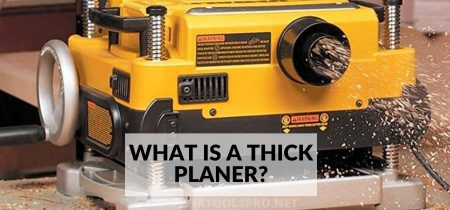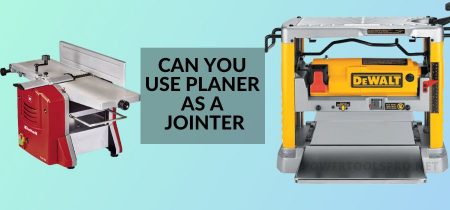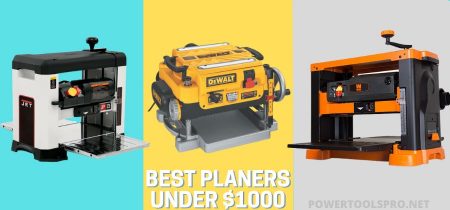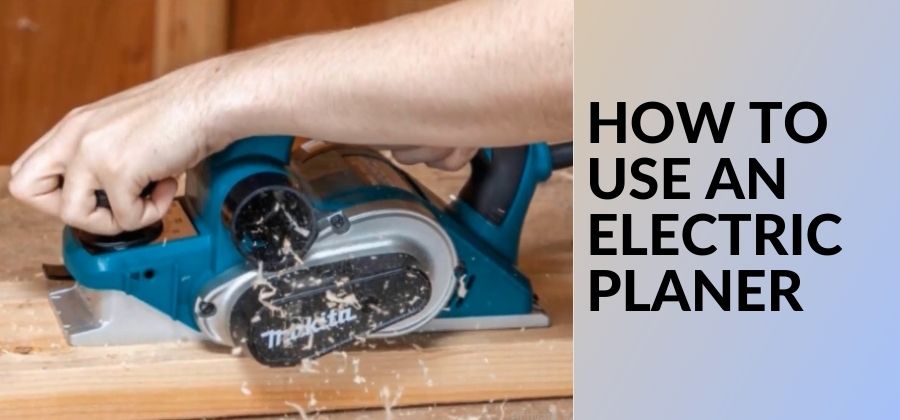
What will you do when you need to shave down a piece of wood but don’t have the right tools? If you’re like me, you probably try to use whatever is closest at hand – which usually isn’t very effective. However, an efficient power tool can help make this process easier: the electric planer.
In this blog post, I will show you how to use an electric planer to get professional-quality results in your home. Stay tuned!
Why do you need a Hand Planer?
In simple words, hand planers are among the user-friendly tools for any carpenter and woodworker. The uses of hand planers are plenty, especially for woodworkers.
Whether you want to eliminate a thin or small amount of material, want to flatten a delicate warped board, or want to create intricate rabbets and profiles, you can use a hand planer to fulfill the task.
Perhaps the most common use of a hand planer is to trim off a thin and delicate wood; however, you can also use it to shave an edge of a sticking door, chamfering a board’s corner, and straighten a twisted or warped wood piece. This is why you will see these handy tools in most carpenters’ arsenal.
Furthermore, you can also use these tools for simple coarse work. Besides, you will also need a hand planer to remove gross and excess amounts of twists, edges, etc., from the fine furniture.
In addition, I have also used this simple to remove a dirty surface of a board before running it through a planer/jointer.
To add further, you can also use a hand planer to trim the extended tops of deck joists before screwing down your deck boards. There are many reasons why you need a hand planer. Another use of a hand planer comes when you have a wide stud, you can easily trim it down with a hand planer. And the list continues.
Why do you need a Hand Planer?
Because sometimes the wood you’re working with is just too old and gnarled for a regular power sander to handle. And when that’s the case, you need something that can really dig in and strip off the extra layer of oxidized wood, providing you the newer, more vibrant color underneath. That’s where a hand planer comes in.
These little handheld power tools can give the “hand-scraped” look, using the adequate method and right cutting depth. So if you’re dealing with old and softwood materials such as pallets, a hand planer is exactly what you need to make it look fresh again.
If you are still thinking, why do you need a hand planer? To summarize, a hand planer is essential if you want to create finely-detailed woodworking projects. Construction workers commonly use it and general contractors for things like shaving down doors, evening out floor joists, etc.
So, a good quality hand planer has various uses in a woodworking shop. To conclude the matter, if you are serious about woodworking, you need a hand planer in your toolkit.
Electric Hand Planer Mechanism – How does it work
The mechanism of an electric hand planer is the same as the nonelectric planer. Electric hand planer also substitutes and uses a fixed blade that rotates and removes more material in no time.
The planer’s blade remains between the metal plates that are also known as the “shoe.” You can easily adjust and set the front shoe, which rotates and moves through a knob.
Generally, the knob is placed at the front of the planer, and using it is also simple. Furthermore, the planer’s depth is minimum, and most hand-held electric planers feature a cutting depth of around 3/32 of an inch.
Moreover, when you push the tool along a wood, the tool’s blade spins at a high RPM. Usually, the RPM is between 10,000 to 20,000, removing smaller materials and providing smooth edges.
How to Use a Planer
Using an electric hand planer is not as difficult as it may sound. Here are some useful tips and hacks about how to use a planer:
Settle Down
The first step to successfully using any woodworking tool is to ensure that you have a stable foundation. You will have to find a level and balanced spot to work on and ensure that both of your feet remain on the ground. It’s also important to be comfortable; you don’t want to be tense or cramped while you’re working.
Once you have a balanced and good base, you can start using your woodworking tool. Just be sure to keep a steady hand and mind your fingers.
Then all depends on the impact and power of your power planner and its speed. Furthermore, check and fine-tune your power planner to match and fulfill the demands of the workpiece.
For instance, if you are planning to deal with lumber, you must adequately set the hand planer’s depth to get the best results. Besides, adjust your tool to 1/64 to get the desired results if you plan to get a smoother and enhanced finishing.
Another thing that most users don’t pay attention to is the sharpness of the blade. Fortunately, most planers come with resharpen-able blades, so you can easily sharpen with a whetstone. Lastly, check the kickstand and its overall position. While using a power planer, ensure the kickstand is elevated and well balanced before making any cut.
Plan the Process
You are ready to start the tool when you have settled down and made all the adjustments. Remember that electric hand planers work through a single shoe or plate, and you need to put the planer’s front shoe on the surface of your workpiece.
Furthermore, keep the workpiece firm and ensure it stays in the same position while using the tool. If the wood piece moves, it can cause extorting, and you might see rough materials. Finally, always clamp the wood piece and hold the device with your hands.
Work Piece Placement Is Essential
Placing wood pieces is essential and can make or break your whole task. In this regard, we will advise you to keep the tool’s front edge on the workpiece and ensure that its blade does not come in contact with the workpiece. Remember, keeping the blade on the workpiece and turning on the electric planer will scratch more wood than needed.
To ensure perfect balance, allow some movement from left to right. Then start the hand planer and run it at high speed.
Hand Placement
While using the power planer, keep your hand in such a way that your working hand remains on the knob just above the front tool’s handle. Moreover, keep your other hand at the handle’s back. Keep in mind that working with both hands gives you proper and even cuts.
Pushing the Wood piece
While using the power planer, gently push the workpiece down the tools as it will remove all the waste accumulated in the device. Try to make a gentle forward and apply constant pressure. However, you can apply extra pressure if needed to avoid tipping or tilting, which can scratch out the wood.
Balance the pressure
Most electric hand planers feature a cut control knob that prevents deep cuts. But still, you can shave or scratch more wood than intended. So, you must ensure the right balance and pressure while using the electric hand planner and move the workpiece to get an even edge.
Tips to Use Hand Planer
- Applying more pressure to the tool’s front gives you a smoother start and decreases the sniping chances.
- Importantly, use the tool with sharp blades as they have a greater and more impact on your cuts.
- You can utilize additional wood to eliminate ‘snipe’ and other issues.
- Always keep the front shoe of the planer evenly on the wood and ensure its blade doesn’t touch the workpiece.
- Start the tool, and allow the motor to reach full speed. Then gradually lower the speed and push it progressively forward.
- Another thing to remember is to keep initial pressure on the front grip while the tool penetrates the workpiece.
- Try to balance even hand pressure between the planer’s handle and front knob when its soles contact the workpiece.
When you push off with your hand planer, be sure not to let go of the rear handle until just before it contacts the wood. This will help avoid overreaching at the end-of pass and dropping the front shoe onto the less desirable area where blades take an uneven bite.
The best way I’ve found is by putting one foot in front of me so that I can still feel what direction it’s going when taking shorter strokes. Lastly, the speed of your hand planner and the depth setting is crucial as it impacts the finishing and smoothness of your work.
How to use power Hand planers on a Wide board
Power hand planers are a great tool for woodworkers of all levels, but they can be especially useful for those working with wide boards. Here are a few tips on how to get the most out of your power hand planer when working with wide boards:
Set the Board
If you plan to work with a handheld planer, the first and most crucial step is the board’s position and placement. Here we advise you to keep the board on an even surface that is broader than the working.
Furthermore, ensure that the wood is steady while you are working on it. Another thing to be cautious about is to keep the board on an elevated area to give enough backing and support to the board.
Additionally, keep the board straight and make necessary adjustments. Try to keep the board in a convex position so the wood stays stationed.
While positioning the wide board, use a marking gauge to define the borders and highlight the board’s most important components. This will ensure that the sides remain equal from one corner to another.
Go Ahead and Plan Your Work
Now you can use your power planer to lessen the board to the defined spots you highlighted in the first stage. Besides, this step includes smoothing the board as per your specific taste.
Here you will also need a winding stick. With the stick, you can easily level the wider areas of your board. This also allows you to eliminate the pressure build-up inside the wood, and eventually, you can form a new size. At this stage, remember to initially cut off 70 percent of the board that you want to even out on the four sides.
Give the Board Time to Settle
After completing the first stage, you must keep the board away for at least two days. The reason for this delay is simple, to determine the actual health and condition of your board before flattening it.
However, some users skip this vital step to finish the task quickly.
You can also skip this easy step but remember the results will be much more fruitful in the end; hence this delay is worth it.
You can use this delay to get your board back in shape and give you time for a quick energy recharge after spending too much energy planning. This delay also allows you to restore the energy you lost during the process.
Finish the Work (Sand it)
When the board is all set, the next thing to do is to sand down it to determine the finishing and smoothing of the board. This might not be that important, but it helps get the desired results. However, be cautious if you follow this step, as it can ruin your previous work. When you start to sand down the board, it helps to give the finer finishing.
To sand down the board efficiently, we recommend using the wide-belt sanding machine if your budget allows, but we guarantee you will get high value for your bucks.
Conclusion
Although this article may not have turned you into a woodworking expert, we hope it has provided you with the details and knowledge you need to use an electric planer like a pro.
Armed with these tips and your newfound confidence, go forth and create beautiful pieces of furniture that will make all your friends jealous. And when they inevitably ask you how to use a hand power planer, be sure to tell them, “I read about it on powertoolspro.net.” Thanks for reading.
